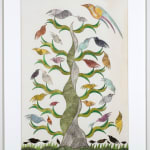SCOTTIE WILSON (1891-1972)
Birds in a Tree, c.1950
signed 'SCOTTIE' (lower centre)
Ink and coloured crayon on board
26.38 x 16.73ins (67 x 42.5cm) (artwork size)
33.86 x 24.02ins (86 x 61cm) (framed size)
33.86 x 24.02ins (86 x 61cm) (framed size)
Copyright The Artist
Currency:
Scottie Wilson was a Scottish artist born in Glasgow on February 28, 1891. Renowned for his intricately detailed style, Wilson was a self-taught artist. Remarkably, he started his artistic career...
Scottie Wilson was a Scottish artist born in Glasgow on February 28, 1891. Renowned for his intricately detailed style, Wilson was a self-taught artist. Remarkably, he started his artistic career at the age of 44, establishing himself as an outsider artist, operating beyond the bounds of the established cultural mainstream.
Wilson's early years were marked by service in the Scottish Rifles, during which he served in India and South Africa before eventually buying himself out in 1911. However, with the outbreak of World War I in 1914, he reenlisted to fight on the Western Front. Following the war, he relocated to Toronto, Ontario, Canada, where he ran a second-hand shop.
It wasn't until 1945, post-war, that Wilson gained recognition for his work, prompting a move to London. There, he exhibited his drawings in unconventional venues for modest fees, harbouring a deep mistrust of art dealers. Despite his scepticism, Wilson's talent quickly garnered attention, leading to a solo exhibition at the Arcade Gallery in London, coinciding with a showcase of 20th-century artists like Picasso, De Chirico, and Klee.
Wilson's unique style, characterised by intricate cross-hatching featuring birds and vegetation, captivated Surrealist luminaries such as E.L.T. Mesens and Roland Penrose, and later, Jean Dubuffet.
In his later years, Wilson resided in Kilburn, London, where he continued to work in solitude, producing his distinctive drawings until his passing in 1972. His legacy endures as one of the most intriguing voices in postwar modern art, celebrated for his unmistakable style and unique approach to artistic expression.
Wilson's early years were marked by service in the Scottish Rifles, during which he served in India and South Africa before eventually buying himself out in 1911. However, with the outbreak of World War I in 1914, he reenlisted to fight on the Western Front. Following the war, he relocated to Toronto, Ontario, Canada, where he ran a second-hand shop.
It wasn't until 1945, post-war, that Wilson gained recognition for his work, prompting a move to London. There, he exhibited his drawings in unconventional venues for modest fees, harbouring a deep mistrust of art dealers. Despite his scepticism, Wilson's talent quickly garnered attention, leading to a solo exhibition at the Arcade Gallery in London, coinciding with a showcase of 20th-century artists like Picasso, De Chirico, and Klee.
Wilson's unique style, characterised by intricate cross-hatching featuring birds and vegetation, captivated Surrealist luminaries such as E.L.T. Mesens and Roland Penrose, and later, Jean Dubuffet.
In his later years, Wilson resided in Kilburn, London, where he continued to work in solitude, producing his distinctive drawings until his passing in 1972. His legacy endures as one of the most intriguing voices in postwar modern art, celebrated for his unmistakable style and unique approach to artistic expression.



